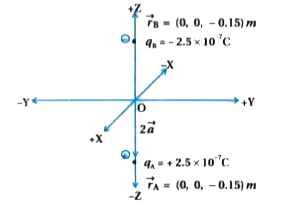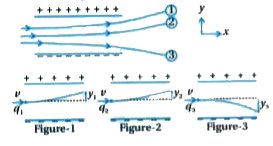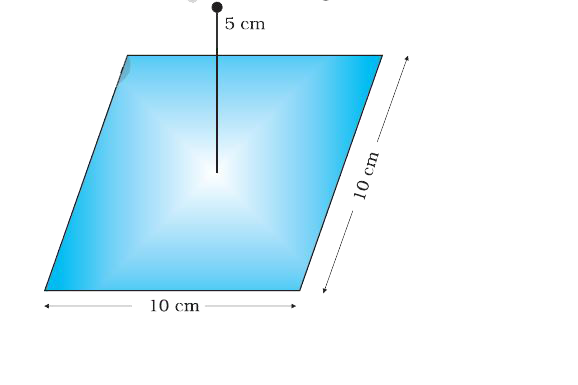Complete Solutions to SECTION B NUMERICALS (NUMERICAL FROM TEXTUAL EXERCISES) of chapter ELECTRIC CHARGES AND FIELDS of Class 12 book with complete answers and questions
| Class 12 | PHYSICS |
| Chapter | ELECTRIC CHARGES AND FIELDS |
| KUMAR PRAKASHAN | SECTION B NUMERICALS (NUMERICAL FROM TEXTUAL EXERCISES) |
| Number Of Questions | 24 |
| Academic Year | 2023-24 |
What is the force between two small charged spheres having charges of `2 xx 10^(-7)C` and `3 xx 10^(-7)` C placed 30 cm apart in air ?
View SolutionThe electrostatic force on a small sphere of charge `0.4 muC` due to another small sphere of charge -0.8 uC in air is 0.2 N.
(a) What is the distance between the two spheres ?
(b) What is the force on the second sphere due to the first ?
View SolutionCheck that the ratio `(ke^(2))/(Gm_(e)m_(p))` is dimensionless. Look up a table of physical constants and determine the value of this ratio. What does the ratio signify ?
View Solution(a) explain the menaing of the statement electric charge of a body is quantised
(b) why can one ignore quantisation of electric charge when dealing with macrosocpic large scale charges
View SolutionWhen a glass rod is rubbed with a silk cloth, charges appear on both. A similar phenomenon is observed with many other pairs of bodies. Explain how this observation is consistent with the law of conservation of charge.
View SolutionFour point charges `q_(A) =2 muC, q_(B) = -5 muC, q_(C) =2 muC`, and `q_(D) = -5 muC` are located at the corners of a square ABCD of side 10 cm. What is the force on a charge of `1 muC` placed at the centre of the square ?
View Solution(a) An electrostatic field line is a continuous curve. That is, a field line cannot have sudden breaks. Why not ?
(b) Explain why two field lines never cross each other at any point ?
View SolutionTwo point charges `q_(A) =3 muC` and `q_(B) = -3 muC` are located 20 cm apart in vacuum.
(a) What is the electric field at the midpoint O of the line AB joining the two charges ?
(b) If a negative test charge of magnitude `1.5 xx 10^(-9)` C is placed at this point, what is the force experienced by the test charge ?

View SolutionA system has two charges `q_A = 2.5 xx 10^(-7)` C and `q_(B) = - 2.5 xx 10^(-7)` C located at points A:(0, 0, -15 cm) and B : (0, 0, + 15 cm), respectively. What are the total charge and electric dipole moment of the system ?

View SolutionAn electric dipole with dipole moment `4 xx 10^(-9)` Cm is aligned at 30° with the direction of a uniform electric field of magnitude `5 xx 10^4 NC^(-1)`. Calculate the magnitude of the torque acting on the dipole.
View SolutionA polythene piece rubbed with wool is found to have a negative charge of `3 xx 10^(-7)` C.
(a) Estimate the number of electrons transferred (from which to which ?)
(b) Is there a transfer of mass from wool to polythene ?
View Solution(a) Two insulated charged copper spheres a and b have their centres separated by a distance of 50 cm what is the nutual force of electrostatic repulsion if the charge on each is `6.5 xx10^(-7)` c the radii of a and b negligible compared to the distance of separation
(b) what is the force of repuslion if each spere is charged double the above amount andf the distance between them is haved
View SolutionSuppose the spheres A and B in Exercise 1.12 have identical sizes. A third sphere of the same size but unchanged is brought in contact with the first , then brought in contact with the second, and finally removed from both. What is the new force of repulsion between A and B ?
View SolutionFigure shows tracks of three charged particles in a uniform electrostatic field. Give the signs of the three charges. Which particle has the highest charge to mass ratio ?

View SolutionConsider a uniform electric field E=`3xx10^(3) hati` N/C (a) what is the flux of this field thriought a square of 10 cm on a side whose plane is parallel to the yz plane (b) hwhat is the flux through the same a `60^(@)`m angle with the x axis
View SolutionWhat is the net flux of the uniform electric field of exercise through a cube of side 20 cm oriented so that its faces are parallel to the coordinate planers
View SolutionCareful measurement of the electric field at the surface of a black box indicates that the net outward flux through the surface of the box is `8.0 xx 10^3 Nm^2//C`.
(a) What is the net charge inside the box ?
(b) If the net outward flux through the surface of the box were zero, could you conclude that there were no charges inside the box ? Why or Why not ?
View SolutionA point charge + `mu` c is a distance 5 cm directly above the centre of a square of side 10 cm as what is the magnitude of the electric flux through the square

View SolutionA point charge of `2.0 muC` is at the centre of a cubic Gaussian surface 9.0 cm on edge. What is the net electric flux through the surface ?
View SolutionA point charge causes an elelctric flux of `-1.0 xx10^(3) Nm^(2) /C` to pass through a spherical gaussioan of 10.0 cm radius centred on the charge (a) if the radius of the gaussian surface wrere doubled how much flux would pas through the surface (b) what is the value of the point charge
View SolutionA conducting sphere of radius 10 cm has an unknown charge if the electric field 20 cm from the centre of the sphere is `1.5 xx10^(3) ` N/C and points radialy inward what is the net charge on the sphere
View SolutionA uniformly charged conducting sphere of 2.4 m diameter has a (a) find the charge on the sphere (b) what is the total eletric fluxd leaving the surface of the sphere
View SolutionAn infinite line charge produces a field of `9xx10^(4)` N/C at a distance of 2 cm calculate the linear charge density
View SolutionTwo large thin metal plates are parallel and close to each other on their inner faces the plates have surface charges densites of opposite region of the first plate (b) in the outer region of the second plate and (c ) between the plates
View Solution
SECTION B NUMERICALS (NUMERICAL FROM TEXTUAL EXERCISES) questions and complete solutions for chapter ELECTRIC CHARGES AND FIELDS of KUMAR PRAKASHAN KENDRA PHYSICS (GUJRATI ENGLISH) of Class 12
All Exercises from KUMAR PRAKASHAN Class 12 PHYSICS ELECTRIC CHARGES AND FIELDS
- SECTION A QUESTIONS- ANSWERS
- SECTION A QUESTIONS- ANSWERS ( Higher Order Thinking Skills (HOTS) Unification Of Electricity And Magnetism)
- SECTION A QUESTIONS- ANSWERS (ADDITIVITY OF CHARGES)
- SECTION A QUESTIONS- ANSWERS (APPLICATION OF GAUSS.S LAW)
- SECTION A QUESTIONS- ANSWERS (BASIC PROPERTIES OF ELECTRIC CHARGE)
- SECTION A QUESTIONS- ANSWERS (CHARGE IS CONSERVED)
- SECTION A QUESTIONS- ANSWERS (CHARGING BY INDUCTION)
- SECTION A QUESTIONS- ANSWERS (CONDUCTORS AND INSULATORS)
- SECTION A QUESTIONS- ANSWERS (CONTINOUS CHARGE DISTRIBUTION)
- SECTION A QUESTIONS- ANSWERS (COULOMB.S LAW)
- SECTION A QUESTIONS- ANSWERS (DIPOLE IN UNIFORM EXTERNAL FIELD)
- SECTION A QUESTIONS- ANSWERS (ELECTRIC DIPOLE)
- SECTION A QUESTIONS- ANSWERS (ELECTRIC FIELD LINES)
- SECTION A QUESTIONS- ANSWERS (ELECTRIC FLUX)
- SECTION A QUESTIONS- ANSWERS (FIELD DUE TO A UNIFORMLY CHARGED THIN SPHERICAL SHELL)
- SECTION A QUESTIONS- ANSWERS (FIELD DUE TO AN INFINITELY LONG STRAIGHT UNIFORMLY CHARGED WIRE)
- SECTION A QUESTIONS- ANSWERS (FIELD DUE TO AN UNIFORMLY CHARGED INFINITE PLANE SHEET)
- SECTION A QUESTIONS- ANSWERS (FORCES BETWEEN MULTIPLE CHARGES)
- SECTION A QUESTIONS- ANSWERS (GAUSS.S LAW)
- SECTION A QUESTIONS- ANSWERS (PHYSICAL SIGNIFICANCE OF DIPOLES)
- SECTION A QUESTIONS- ANSWERS (THE FIELD OF AN ELECTRIC DIPOLE)
- SECTION A QUESTIONS- ANSWERS (TRY YOURSELF )
- SECTION B NUMERICALS (ADDITONAL EXERCISE)
- SECTION B NUMERICALS (NUMERICAL FOR .DARPAN. BASED ON TEXTBOOK)
- SECTION B NUMERICALS (NUMERICAL FROM TEXTUAL EXERCISES)
- SECTION B NUMERICALS (NUMERICAL FROM TEXTUAL ILLUSTRATIONS)
- SECTION C NCERT EXEMPLAR SOLUTION (LONG ANSWER TYPE QUESTIONS)
- SECTION C NCERT EXEMPLAR SOLUTION (MULTIPLE CHOICE QUESTIONS (MCQs))
- SECTION C NCERT EXEMPLAR SOLUTION (MULTIPLE CHOICE QUESTIONS (MORE THAN ONE OPTION))
- SECTION C NCERT EXEMPLAR SOLUTION (SHORT ANSWER TYPE QUESTIONS)
- SECTION C NCERT EXEMPLAR SOLUTION (VERY SHORT ANSWER TYPE QUESTIONS)
- SECTION D (MULTIPLE CHOICE QUESTIONS (MCQS)) (MCQS FROM .DARPAN. BASED ON TEXTBOOK) (ASSERTION AND REASON TYPE MCQs)
- SECTION D (MULTIPLE CHOICE QUESTIONS (MCQS)) (MCQS FROM .DARPAN. BASED ON TEXTBOOK) (CONTINUOUS DISTRIBUTION OF CHARGE AND ELECTRIC FLUX)
- SECTION D (MULTIPLE CHOICE QUESTIONS (MCQS)) (MCQS FROM .DARPAN. BASED ON TEXTBOOK) (ELECTROSTATIC ELECTRIC CHARGE AND FRICTIONAL ELECTRICAL CHARGE)
- SECTION D (MULTIPLE CHOICE QUESTIONS (MCQS)) (MCQS FROM .DARPAN. BASED ON TEXTBOOK) (LECTRIC FIELD AND ELECTRIC DIPOLE)
- SECTION D (MULTIPLE CHOICE QUESTIONS (MCQS)) (MCQS FROM .DARPAN. BASED ON TEXTBOOK) (MISCELLANEOUS MCQs)
- SECTION D MCQS ASKED IN COMPETITIVE EXAMES (MCQS AKSED IN BOARD EXAM AND GUJCET)
- SECTION D MCQS ASKED IN COMPETITIVE EXAMES (MCQS ASKED IN AIEEE AND JEE MAINS)
- SECTION D MCQS ASKED IN COMPETITIVE EXAMES (MCQS ASKED IN CBSE-PMT AIPMT NEET)